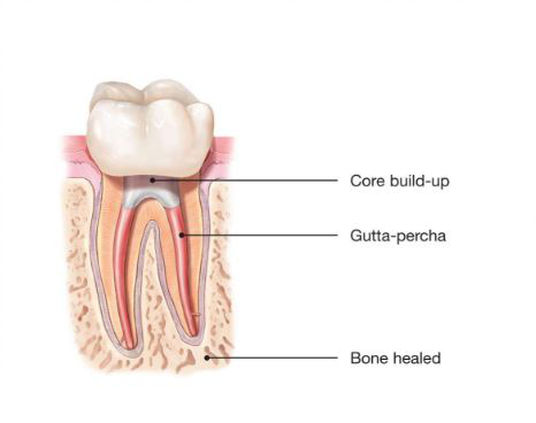
What is the basic Tooth Anatomy?
The external part of a tooth is called Enamel and is extremely hard but very little sensitive. When damaged by decay remains generally asymptomatic.
Deeper than the enamel we find the Dentin; it is less hard but contains cellular elements: if affected causes various degree of discomfort.
The most internal part of a tooth is called Dental Pulp. The pulp is a tissue made up of nerves, connective tissue and blood vessels. When involved in the carious process responds with a growing level of inflammation. Part of the pulp is located in tiny space inside each root: the Root Canal .

What are a Root Canal symptoms?
When there is a large decay in a tooth, sometime when we place an extensive restoration (filling or crown) or if the tooth has been subjected to trauma, the pulp may become inflamed or may die.
When this happens usually means trouble.
Dental Pulp disease can cause various symptoms, from severe sensitivity to cold or hot till excruciating toothache (Acute Pulpitis) or remain pain free. When the pulp dies, the space where it is located (the Root Canal) rapidly becomes infected with bacteria. This may cause pain and swelling in the supporting tissues (abscess) or the tooth may remain symptom-free. The symptoms of an abscess can range from a dull ache to severe pain and often the tooth is very tender when you bite.In some cases the tooth can darken in colour which may suggest, in absence of other signs, that the nerve inside has died (or is dying).

Why a Root Canal Treatment?
The purpose of root canal treatment is to remove the inflamed tissue or bacteria inside the root canal allowing the surrounding tissues to heal. After cleaning the root canal system,
The space created is filled with a root filling to prevent reinfection. A material called guttapercha is used as the standard root filling material. This a natural substance very similar to rubber. The treatment is time consuming because of its complexity, but can readily be done using modern local anaesthetic techniques with little or no discomfort.

What happens after a Root Canal ? Postoperative care
It is normal for patients to experience some soreness after treatment as the supporting tissues of the tooth may be a little bruised. In a limited number of cases the tooth can go through an acute episode of inflammation and swelling, immediately after or between visits (Flare up).
This is usually dealt with a course of antibiotics. Various degrees of postoperative discomfort, easily treated with simple painkillers, although very worrying for the patient, do not compromise the long term success of the procedure. When the treatment has been completed the rootfilled tooth should be restored with a crown to provide extra strengtht to a structure that has been weakened and to prevent a possible fracture.
This event on the contrary would lead to complex restorative work and often tooth extraction.

